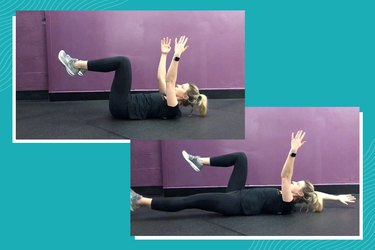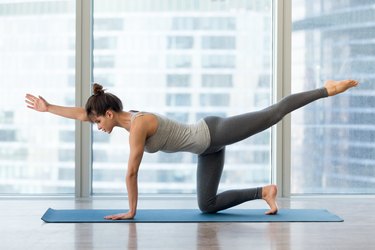
The dead bug exercise is one of the best ab exercises you're probably not doing.
A small, no-crunch core movement, the dead bug requires a little extra coordination. But once you get the hang of it, you'll be on your way to a stronger foundation, which can decrease back pain, make everyday tasks like walking and lifting heavy objects easier and improve athletic performance.
Video of the Day
"Almost anyone can benefit from the dead bug, as it teaches you to engage your core," Caroline Freeman, group fitness manager at Crunch Fitness, tells LIVESTRONG.com.
Not only is an engaged core required for exercises like squats and deadlifts, it's also a key component to almost all other types of exercise, like archery or Zumba, for instance.
Performed on a regular basis, stabilization exercises like dead bugs can also help alleviate chronic lower back pain, especially when paired with walking, according to a June 2019 study in the journal Medicine.
How to Do the Dead Bug Exercise With Proper Form
The dead bug is an ab exercise that uses controlled, isolated movements. The starting position is flat on your back, with your arms pointing straight up in the air and both legs bent up at a 90-degree angle, resembling — what else? — a dead bug.
Slowly and with control, you alternate lowering one arm over your head while extending the opposite leg to the ground and bringing them back up while keeping your core engaged and your lower back pressed to the floor.
- Lie flat on your back with both arms reaching straight toward the ceiling.
- Lift your feet off the ground so your legs are bent at a 90-degree angle.
- Keep your lower back in contact with the floor through the entire duration of the exercise.
- Slowly and with control, extend your right arm and left leg away from each other.
- Lower your limbs as far as you can while keeping your lower back on the ground. Fight the impulse to arch your back by tightening your abs, pressing your bellybutton down to anchor your lower back to the floor.
- Exhale as you return your right arm and left leg to the starting position with the same slow, controlled movement.
- Repeat with your left arm and right leg, then return to center again. This counts as 1 rep.
Tip
If your lower back begins to peel away from the floor as you stretch your limbs, don't extend your arms or legs quite as low to the ground. Keeping your back pressed into the ground is more important than reaching the floor with your hands or feet. Work up to the full range of motion over time.
How Many Dead Bugs Should You Do?
Beginners should start with 3 sets of 5 reps. In two weeks, if you can keep your lower back in contact with the floor for the full extension and duration of the exercise, increase to 4 sets of 8 reps. Work up to 5 sets of 12, and add in variations (like the ones below!) to increase the intensity.
You can do dead bugs every day or work them into your rotation of core-stabilizing exercises like bird dog, bridge and plank.
The Benefits of Dead Bugs
"Everyone can benefit from a dead bug," Freeman says. Beginners can use it to strengthen and stabilize their cores, while more experienced athletes can progress to more advanced variations.
Starting each workout with a warm-up that includes dead bugs can send a signal to your muscles (from head to toe) that they're about to get busy.
1. They Build a Stronger and More Stable Core
The dead bug is targets your lower abs, called the transverse abdominal muscles, and the muscles that run along your spine, the erector spinae, which support your lower back.
A few rounds will activate your trunk and core through isolation and stabilization to prevent back pain and promote more fluid movement.
"Commonly practiced compound movements, such as squats, deadlifts, push-ups and pull-ups, require the isolation and stabilization of the trunk to prevent back pain," Freeman explains.
2. They Improve Lower Back Pain
Core stabilizing exercises like the dead bug put the focus on the muscles of the lower abs and pelvis, according to the American Council on Exercise. Improved strength along the entire front of your core provides more support to the back, helping to decrease pain and make everyday movements easier.
3. They Boost Coordination
Moves like dead bugs that involve your whole body activate your brain in a pretty remarkable way. The dead bug "requires both sides of the brain to work together, because limbs on both sides of the body have to move synchronously (called a contralateral movement pattern)," writes personal trainer Brett Klika for the American Council on Exercise.
Contralateral movement reinforces the connection between the two hemispheres of the brain to improve coordination, which makes these types of exercises a smart move for people of all fitness levels.
4. They Can Be Done Anywhere
The dead bug exercise doesn't require any equipment, so you can do it just about anywhere, at any time. "Incorporating dead bugs at the beginning of your workout program will help prime your core muscles for compound movements," Freeman says.
Try adding them to your warm-up, a HIIT cardio workout or a core routine. A mat can be helpful, but it's not necessary.
Dead Bug Modifications
This seemingly simple movement is harder than it looks. Dial back the intensity when you're first starting out with these tweaks.
1. Supported Dead Bug
The first few times you perform the exercise, use a yoga block, foam roller or or stability ball to keep one arm and one leg in place.
- Lying on your back, raise your hands straight up and lift your feet off the floor by bending your knees to 90 degrees.
- Place a horizontal yoga block, foam roller or inflated stability ball between your right elbow and right knee.
- Keeping the yoga block or ball in place, raise and lower your right arm and right leg to the floor.
- Lift back up to the starting position. Complete 5 repetitions, then switch sides.
- After several sessions, try 5 reps on each side without the prop while keeping your back flat against the floor.
Tip
This modification also helps you keep your back from arching as you perform the exercise.
2. Heel Tap
It's fairly common to experience clicking in your hips as your legs extend in the dead bug, Freeman says. To troubleshoot, don't extend your knee when you lower your leg to the floor.
- Lying on your back, raise your hands straight up and lift your feet off the floor by bending your knees to 90 degrees.
- Lower your right leg down toward the ground and tap your right heel lightly on the floor.
- Return to starting position.
- Switch sides and repeat. With continued practice, you can work toward fully extending the leg, Freeman says.
Dead Bug Exercise Progressions
Once you can perform 5 sets of 12 repetitions of the basic dead bug with ease, try these variations to keep your midsection challenged. Only attempt these if you can keep your back from arching off the ground.
1. Straight-Leg Dead Bug
Increase the work for your core by keeping your legs straight throughout the entire exercise.
- Lying on your back, raise your hands straight up and lift your feet off the floor to 90 degrees, keeping your legs straight.
- Slowly and with control, extend your right arm and left leg away from each other.
- Lower your limbs as far as you can while keeping your lower back on the ground. Fight the impulse to arch your back by tightening your abs, pressing your bellybutton down to anchor your lower back to the floor.
- Exhale as you return your right arm and left leg to the starting position with the same slow, controlled movement.
- Repeat with your left arm and right leg, then return to center again.
2. Weighted Dead Bug
Hold a weight, like a dumbbell, while doing the dead bug exercise to increase the resistance and boost your muscle gain.
- Lie flat on your back with both arms reaching straight toward the ceiling. Hold a dumbbell horizontally with one hand on each end of the dumbbell.
- Lift your feet off the ground so your legs are bent at a 90-degree angle.
- Keep your lower back in contact with the floor through the entire duration of the exercise.
- Slowly and with control, extend both arms and right leg away from each other.
- Lower your limbs as far as you can while keeping your lower back on the ground. Fight the impulse to arch your back by tightening your abs, pressing your bellybutton down to anchor your lower back to the floor.
- Exhale as you return both arms and right leg to the starting position with the same slow, controlled movement.
- Repeat with both arms and your left leg, then return to center again.
Tip
Choose a weight that will allow you to perform at least 3 sets of 5 reps without lifting your back from the floor or causing pain or pulling in your extremities or core.
3. Resistance Band Dead Bug
This not only calls on your core even more, it also taxes your legs and glutes.
- Lie flat on your back with both arms reaching straight toward the ceiling. Loop a mini band around your feet.
- Lift your feet off the ground so your legs are bent at a 90-degree angle.
- Keep your lower back in contact with the floor through the entire duration of the exercise.
- Slowly and with control, extend your right arm and left leg away from each other.
- Lower your limbs as far as you can while keeping your lower back on the ground. Fight the impulse to arch your back by tightening your abs, pressing your bellybutton down to anchor your lower back to the floor.
- Exhale as you return your right arm and left leg to the starting position with the same slow, controlled movement.
- Repeat with your left arm and right leg, then return to center again.
Incorporate the Dead Bug Into Your Workout
You can feature the dead bug in any number of different exercise plans, but if you want some ideas for ab workouts where it's a perfect fit, try:
Was this article helpful?
150 Characters Max
0/150
Thank you for sharing!
Thank you for your feedback!



